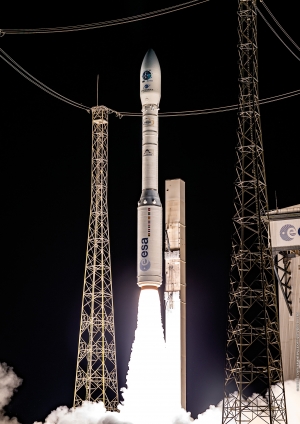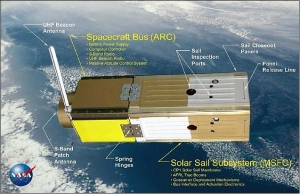Displaying items by tag: propulsion
Vega - rocket
Vega (Vettore Europeo di Generazione Avanzata - European Advanced Generation Carrier) is an expendable launch system developed for Arianespace jointly by the Italian Space Agency (ASI) and the European Space Agency (ESA). Italy is the leading contributor to the Vega program of ESA; other participants include France, Belgium, Spain, The Netherlands, Switzerland and Sweden. 1) 2) 3) 4)
The program began in 1998, it is managed jointly by an IPT (Integrated Project Team) composed of staff from ESA, ASI and CNES. The industrial consortium for the construction of the launcher is lead by the prime contractor ELV S.p.A. of Italy.
NanoSail-D2
NanoSail-D2 is a technology demonstration experiment of NASA with the primary objective to deploy a compact solar sail boom system in space.
In a previous attempt, a team from the NASA/MSFC, along with a team from the NASA/ARC (Ames Research Center), developed a solar sail mission called NanoSail-D which was lost in a launch failure aboard a Falcon 1 rocket on August 3, 2008.
Two units of the NanoSail-D satellites have been built. NASA/MSFC plans to launch the backup NanoSail-D payload from a 3U CubeSat (nanosatellite) of ARC on the FASTSat-HSV mission. FASTSat is required to launch the nanosatellite before the NanoSail-D2 payload can be launched and deployed from the nanosatellite.
MEPS - Micro-satellite Electric Propulsion System
MEPS (Micro-Satellite Electric Propulsion System) is a three year programme started in 2013, jointly supported by the European Space Agency (ESA) and the Israeli Space Agency (ISA) and aimed at the qualification of a propulsion system based on a low power, low cost Hall Effect Thruster (nominal power level 200W).
The system consists of a dual thruster/cathode subsystem, a power processing unit, propellant management assembly, feeding lines and a suitable Xe tank and
is conceived as a 'plug and play' system that can be easily installed on a number of small space platforms. It is intended to provide a prompt, effective response to the market needs, where small platforms can highly benefit from a low-cost, low-mass propulsion system. A suitable solution for drag compensation, orbit maintenance, end-of-life deorbiting and the exploitation of the lower layers of the LEO region, MEPS is going to pave the way to a new class of affordable and capable small space missions
Provision of a space-qualified Hall Effect Thruster (HET) subsystem for low-power space missions.
reference: article
Alta SpA
Alta is a leading European small company in the aerospace propulsion sector. We operate in research and development on space electric propulsion, chemical propulsion andaerothermodynamics. Our company provides testing services, high vacuum systems and facilities and space systems design and computational simulation tools. With a successful record of technology transfer cases, we are also active in the energy and industrial plasma sectors.
With propulsion systems suited to a variety of missions - from interplanetary probes to low-cost microsatellites - Alta covers the broadest EP technology range among European companies. Alta’s researchers and engineers make up the largest and most experienced European R&D team working on EP, with know-how and capability in all EP application fields.
- Hall Effect Thrusters
- MagnetoPlasmaDynamic Propulsion (MPD)
- Field Emission Electric Propulsion (FEEP)
- Resistojet Propulsion
- Diagnostics for Electric Propulsion
Alta’s excellence in Electric Propulsion (EP) technologies is demonstrated by a long record of achievements:
- 1974: first European Pulsed Plasma Thruster
- 1980: first European quasi-steady Magneto-Plasma-Dynamic Thruster
- 1994: first European Hall Effect Thruster
- 1999: first integrated FEEP micro-thruster
- 2001: first European high power Hall Effect Thruster
- 2004: first European miniaturized Hall Effect Thruster
- 2005: largest European electric propulsion testing facility
The Elwing Company
The Elwing Company conceives, designs, develops, manufactures and markets advanced propulsion systems for satellites.
It designs and commercializes Electric Propulsion (EP) systems for satellites and spacecraft.
Based on an innovative electrodeless plasma thruster technology – The E-IMPAcT technology (Electrodeless-Ionization Magnetized-Ponderomotive Acceleration Thruster), our propulsion systems are designed to fulfill the propulsion needs of most spacecraft operators & manufacturers in the United States and throughout the world.
Established in 2002, The Elwing Company is privately held and has offices, affiliates and subsidiaries throughout the U.S. and in Europe. It developed and holds exclusive rights on the electrodeless plasma thruster technology.
ECAPS
ECAPS, founded in 2000, is a Swedish company with focus on Green Propulsion based products for space applications.
ECAPS aims to simplify the access to space for satellite and launcher systems. ECAPS holds a number of patents worldwide for a family of ADN (Ammonium DiNitramide) based propellants, catalyst, thruster design and manufacturing methods.
ECAPS is part of the SSC Group.
The key resource of ECAPS is its highly skilled team of engineers and researchers with a proven track record to develop, manufacture and deliver propulsion components and systems. ECAPS has its development and hardware manufacturing facilities in Solna in the greater Stockholm area. The propellant is manufactured at EURENCO Bofors in Karlskoga and ECAPS hot firing test facility used for rocket engine development is located at the Swedish Defence Research Agency's (FOI) premises in Tumba just south of Stockholm.
Integrated Exciter System (propulsion)
Dynetics propulsion experts have developed a vacuum-rated, high voltage exciter system.
The system has many advantages over traditional exciter/ignition systems.
Features of the Integrated Exciter System:
- Lightweight
- Highly integrated
- Low power requirements
- Space rated
- Hermetically sealed design eliminates EMI leakage unlike traditional spark systems
- Close coupled plug and exciter eliminates need for a high voltage spark exciter wire, which is plagued with EMI leakage challenges
Company: Dynetics
Orbital Technologies Corp (Orbitec)
ORBITEC is a subsystems integrator and high technology development company based in Wisconsin, USA.
ORBITEC offers solutions and strong capabilities in five distinct areas:
- Propulsion, Space Resources, and Energy
- Emergency Response Systems
- Human Support Systems and Instrumentation
- BioProducts and BioProduction Systems
- Interactive 3D Systems and Services
Swiss Propulsion Laboratory
The Swiss Propulsion Laboratory (SPL), founded in autumn 1998, is running integrated programs focusing on research and development of space-technology in Switzerland.
Objectives and Strategies
SPL aims to develop, build and run reasonable priced systems to transport small payloads into a low-earth orbit (LEO). Old and established paths are intentionally renounced in order to envisage new and innovative concepts covering impacts on our environment as much as possible.
Involving external facilities and inviting other organizations to participate allows SPL to achieve its objectives. The components will be developed in a joint effort of SPL, interested universities, graduate schools and Switzerland precision industry. SPL will provide the required co-ordination of all involved parties, for example by extracting and forwarding precisely defined technical problems to educational institutions, thereby enabling them to effectively take part in space-technology oriented "applied science".
Aerospace Propulsion Products
Aerospace Propulsion Products B.V. (APP) is a Dutch company providing igniters for launcher engines.
APP develops and produces igniters for the engines of the space launchers Ariane 5 and VEGA. APP has facilities and dedicated equipment for production and testing of solid propellant grains, HNF (hydrazinium nitroformate) and for the assembly of gas generators. APP has temperature and humidity controlled rooms for propellant mixing, casting and curing. Such facilities are also available for assembly of gas generators. A pilot plant for the production of HNF is available, producing HNF both for research purposes but also on a commercial basis. In January 2008, APP has opened a second production facility dedicated to the production of cool gas generators.
It is a joint venture of Stork and TNO.










